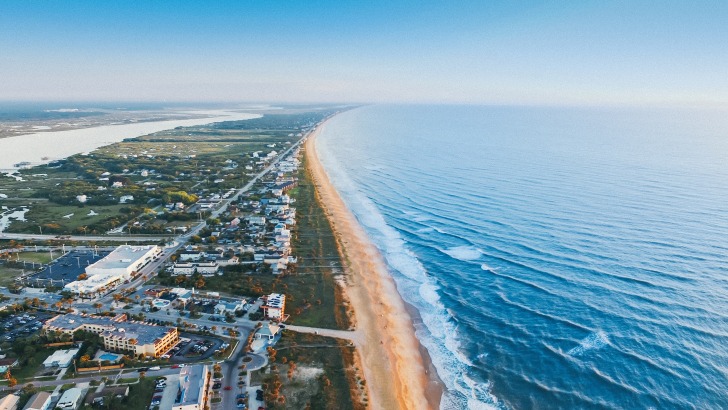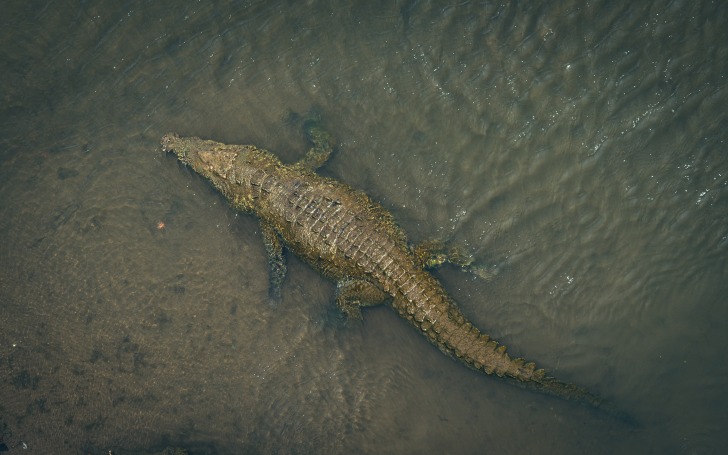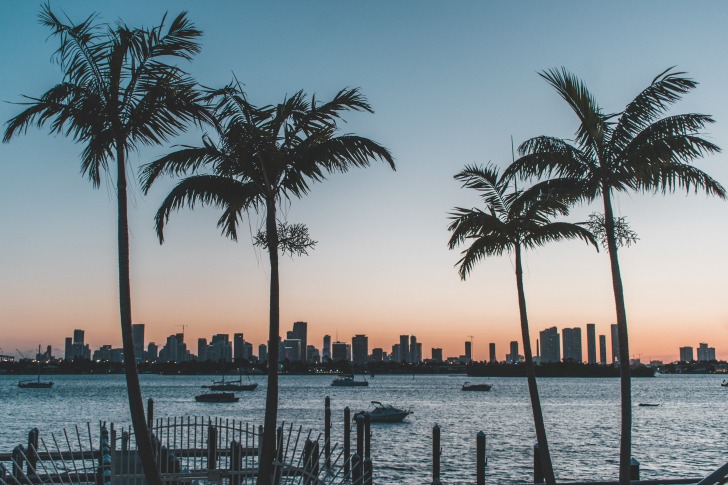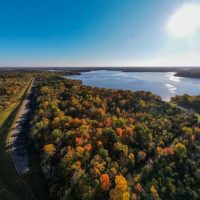I know that people often post hoaxes on Facebook to scare people about wild animals that have escaped.
The post about alligators on the loose in Florida is true though.
I swear I am not making this up (and am sure no one else is making this up either).

Contents
- So… Are There Alligators in Florida?
- Alligator Species in Florida
- About The American Alligator
- Crocodiles
- Is it Safe to Swim in Florida?
- Interesting Alligator Facts in Florida
- Alligators vs. Crocodiles
- 3 Safety Tips for Swimming in Alligator-infested Waters
- Summary
- Florida Safety Overview
- Frequently Asked Questions
So… Are There Alligators in Florida?
The real question should be, “where aren’t alligators in Florida?”
One place you have to watch out for them in April 2022 is Venice.
According to USA Today’s Asha C. Gilbert, police told Facebook users to “beware” when walking on Venice streets.
On the contrary, I can’t say that I’ve ever had to worry about an alligator walking down the street where I live.
A bear maybe, or a snake or deer would, but an alligator most likely wouldn’t.
That’s unless it’s a pet on the run.
Anyway, I don’t know what I’d ever do if I lived in or visited Florida.
I say that’s a small price to pay for a little sunshine, but it is scary.
I bet confronting an alligator has to cause some sort of post-traumatic stress for some potential victims.
Other places you might see alligators include Bravard and Orange Counties.
In fact, all 67 Florida counties have alligators in their presence either in the wild or at a designated refuge.
Lake George in Volusia and Putnam Counties, connected to St. John’s River has the most gators.
Lake Kissimmee, which is about two hours driving distance (73 miles) from Orlando, has the second highest number of alligators in Florida, as reported between 2019-2022.
Alligator Species in Florida
Native to the United States, you could assume it’s the American alligator that hangs around in Florida.
It’s the only species native to this land.
You’ll find the American Crocodile too.
However, it mostly resides in the Everglades, a wildlife refuge near Miami and Fort Lauderdale.
You might also see them in Palm Beach. Pinellas and Sarasota Counties, and other coastal regions.
About The American Alligator
The American Alligator is one of the two surviving alligator species besides the Chinese Alligator.
It prefers to live in freshwater locations.
That’s because it doesn’t process salt as easily as the Crocodile does.
The American Alligator is larger than the Chinese Alligator, measuring about 11-15 feet long.
In contrast, the Chinese Alligator only measures about 5-7 feet long.
It prefers warmer, tropical waters, such as marshes and swamps.
Crocodiles
The American crocodile shows up in southern Florida.
It prefers saltier waters than the American Alligator.
That’s because it has salt glands that allow for easier processing than for an alligator.
American crocodiles like to live on cays, also known as sandy islands.
You will also see them in lagoons, swamps, or brackish (saltwater) lakes near the ocean.
This species is one of four surviving of its kind in the world.
Some of them grow to longer than 20 feet.
The average length ranges from 9-13 feet for males.
Is it Safe to Swim in Florida?
People do swim here and live to tell about it.
I am one of them, having been to Clearwater Beach once.
Therefore, it is usually safe to swim in Florida.
I was always warned about jellyfish or sharks, never alligators.
Still, they’re all across Florida, so exercise caution when swimming.
Comments About Alligators Showing Up In Weird Locations
In 2019, the Florida alligator population totaled about 1.3 million.
This same year, Kelli Bender of People Magazine said, “Even if alligators aren’t native to your state, there’s a chance you could find one of these reptiles in your backyard.”
That means you don’t have to live in the same state as alligators to feel the danger.
They do sometimes show up in other states, such as the one found in Chicago, Illinois at Humboldt Park.
This one may have been a pet though.
The owners allegedly abandoned it.
Anyway, Florida remains one of the most popular vacation and retirement spots because of its beaches.
It’s also a favorite place for spring breakers to put away study materials — and get this — even their mobile devices to spend some time relaxing in the sun and swimming.
Beaches can provide a source of solace and take away your stress and anxiety.
However, the troubles here can also add to your emotional turmoil.
Aside from the presence of alligator sightings in Orlando, Sarasota, or Lakeland (Central), Florida, you may also deal with high tides and hurricanes.
Other swimming areas may have high contamination levels, so you may see “no swimming” signs posted there.
You may not have to worry as much about the public beaches.
However, you still will want to read reports of where to expect the American Alligator or the American Crocodile to show up.
Lifeguards on duty at the main beaches will alert you of danger.
Heed their warnings.
A report from 2019, for instance, said that a sighting occurred in Panama City.
Check county websites of where you are going for the latest alerts before you swim.
Other Warnings for Swimmers
It’s wise to check out recent water quality reports.
This will let you know what beaches may have shut down temporarily because of high bacteria counts.
However, the state does say if the beach is closed to the public, it won’t be monitored and its quality will not be reported.
Still, you can refer to the Beach Water Quality Report for the best information about Florida beach safety before swimming.

Interesting Alligator Facts in Florida
About that Venice, Florida April 2022 alligator sighting: The police said the alligator estimated to measure about 10 feet long was in the drainage ditch.
Authorities suspected that he came from a nearby lake before meandering to the corner of Bird Bay Circle and Bird Bay West.
The Herald-Tribune tells more of the story, revealing that this alligator measured 10 feet 8 inches.
Trappers who first found this alligator pulled it out of a pond near the Pelican Pointe Golf & Country Club.
Bob Gada, one of the persons who spotted the alligator, reported its sighting near the 15th tee box.
In April 2022, Earle Kimel reported that this large reptile had resided in that nearby pond for about a year.
Other Recent Florida Alligator Sightings
Not all alligator sightings are “peaceful” like the one that happened in Venice, FL in May 2019.
In Clearwater, an 11-foot gator busted through a kitchen window.
CBS news Caitlin O’Kane reported, “Imagine waking up in the middle of the night, walking into the kitchen to get a midnight snack — and then almost becoming a snack yourself.”
The homeowner contacted both the police and a trapper.
No injuries occurred during the catching of this intruding reptile.
I’m surprised it didn’t get cut by the glass – must have pretty thick skin.
I didn’t see any word of how the homeowners felt, but I can imagine them having been startled by this unexpected reptilian invasion.
About a month earlier, another home alligator invasion occurred.
In Sarasota, FL the 11-foot gator didn’t break any windows.
Another one was found at the Orlando Airport, but one of the largest sightings since 2017 was the 800-pound one.
This gigantic alligator was spotted in Central Florida and received the nickname “Mister Humpback.”
Reasons for Rising in Alligator Sightings
People who live in Florida probably don’t think much of it.
I imagine after a while they expect it and prepare for “alligator drills” like we Wisconsinites prepare for tornado warnings.
Reasons for alligators roaming the streets include the search for food.
They also venture out to find a mate, and just like the rest of us, the sun apparently does their bodies some good.
That’s not necessarily the primary reason for an increase in the wandering of male alligators though.
Usually, increased alligator sightings happen during mating season.
This procreation period usually starts in April with the process of attracting a female to reproduce offspring with.
That’s followed by a May and June mating period.
Of course, not all alligators probably can find and keep a mate.
If they are successful, however, the mating typically results in the female laying at least two and possibly three dozen eggs by July.
Alligators vs. Crocodiles
Many sources don’t consider the American Crocodile actually native to the United States.
The only portion that exists in the U.S. is in Southern Florida.
It’s different from the American Alligator, which shows up in at least seven states.
Hard to Tell Them Apart
I didn’t realize at first how hard it could be to tell some species of alligators and crocodiles apart.
That explains why some researchers say that crocodiles aren’t native to the U.S.
To clarify, the northernmost location where the American crocodile inhabits is Southern Florida.
You might have the hardest time telling an alligator apart from a crocodile in the Everglades.
That’s the only place in Florida where both the alligator and crocodile coexist.
Main Alligator Vs. Crocodile Differences
Crocodiles typically have some gray, but some of them do have green, tan, or brown hues.
The young ones have dark stripes on a light (off-white or cream) background.
Alligators typically have dark skin with yellow stripes when young.
They’re typically darker than crocodiles, appearing dark gray.
Some of them may have some hints of dark green, especially if living in seaweed or algae swamps.
More of the bottom row of teeth of a crocodile stick out than on an alligator.
That’s because their jaws are different sizes, unlike the alligator.
You will still see some of the alligator’s teeth though.
3 Safety Tips for Swimming in Alligator-infested Waters
1. Never, ever feed an alligator.
Most states where alligators exist tell you not to feed them.
You especially shouldn’t throw fish scraps in the water or any food at all toward them.
They may appear friendly, and they don’t usually attack unprovoked (although many have), but you should coexist mostly by avoidance.
2. If you see an alligator, report it.
Reporting an alligator sighting – whether on the beach or in a nearby neighborhood – could save people from injuries.
Capturing professionals will retrieve it and move it away from common swimming locations or from nearby tourist attractions.
3. Follow touring guidelines.
If on a guided tour where you have the privilege of viewing alligators up close, don’t try to do anything you’re told not to do.
They’re usually confined enough where you can’t pet them, but don’t do it even if you can see a chance of access to them.
Summary
About 1.3 million American Alligators live in Florida.
Some American Crocodiles do live here as well, coexisting with the alligators in the Everglades.
Florida Safety Overview
READ THE FULL REPORT: Florida Safety Review
Safety Index:
- OVERALL RISK: MEDIUM
- TRANSPORT & TAXIS RISK: MEDIUM
- PICKPOCKETS RISK: MEDIUM
- NATURAL DISASTERS RISK: MEDIUM
- MUGGING RISK: MEDIUM
- TERRORISM RISK: HIGH
- SCAMS RISK: MEDIUM
- WOMEN TRAVELERS RISK: LOW
Frequently Asked Questions
How many people die each year from alligator attacks in Florida?
About 26 fatal bites occurred by alligators between 1948-2021.
This totals about one fatal injury every three years.
A person has suffered from a non-fatal attack once every six years from 1948 to 2021.
What do alligators eat?
They typically eat any animal they can find – turtles, snakes, mammals near the shore, and fish are only some.
Oh, and they eat birds.
These, prefer humans but have in a pinch resorted to eating a person, but that’s rare.
Can you bring pets swimming in Florida?
You probably can find lakes, rivers or streams, and beaches where they allow dogs.
However, it’s best not to bring them near bodies of water where alligators live.
Gators sometimes perceive them as potential prey.
Can you bring children near alligators?
This may seem like a strange question to ask.
I say only if they’re in a confined aquarium or another vessel should you allow children to view them.
Never, under any circumstances, pet them or have your child pet them.











